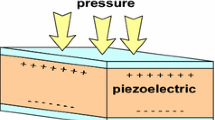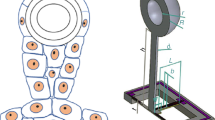Abstract
This paper reports on recent developments to improve the performance of hair vector hydrophone by means of several technological advancements in the fabrication procedures and corresponding sensor design. With fish’s lateral line organs as prototypes, NEMS (Nano-Electromechanical System) vector hydrophone with directivity has been designed. This paper describes the meso-piezoresistance effect of resonant tunneling thin-film, and the NEMS hydrophone based on this effect is highly sensitive and small size. The application of bionics structure may improve the low-frequency sensitivity of hydrophone. The calibration test shows that NEMS vector hydrophone’s receiving sensitivity is up to −170 dB (0dB = 1 V/μPa), has a good directional pattern in the form of “8” shape. The sea test shows that the direction of target can be detected by single NEMS vector hydrophone. In the anechoic tank, it has been verified that NEMS vector hydrophone can track the trajectory of the moving target.













Similar content being viewed by others
References
Abraham BM (1996) Low-cost dipole hydrophone for use in towed arrays. In: Berliner MJ, Lindberg JF (eds) Acoustic particle velocity sensors: design, performance, and applications. AIP, Woodbury, NY, pp 189–201
Aubauer R, Lammers MO, Au WWL (2000) One-hydrophone method of estimating distance and depth of phonating dolphins in shallow water. J Acoust Soc Am 107:2744–2749
Chen HW, Zhao JW (2003) On locating low altitude moving targets using a planar acoustic sensor array. Appl Acoust 64:1087–1101
Coombs S, Montgomery JC (1999) The enigmatic lateral line system. In: Popper AN, Fay RR (eds) Comparative hearing: fishes and amphibians. Springer handbook of auditory research, vol 11. Springer, New York, pp 319–362
D’Spain GL, Hodgkiss WS, Edmonds GL et al (1992) Initial analysis of the data from the vertical DIFAR array. In: IEEE oceans conference, pp 346–351
Dawson P, Duggan G, Ralph HI (1985) Positions of the sub-band minima in GaAs-(AlGa)As quantum well heterostructures. Superlattices Microstruct 1:231–235
Gordienko VA (1994) Absolute pressure calibration of acoustic receivers in a vibrating column of liquid. Acoust Phys 40:243–246
Jande S (1966) Fine structure of lateral-line organs of frog tadpoles. J Ultrastruct Res 15:496–509
Leslie CB, Kehdall JM, Jones JL (1956) Hydrophone for measuring particle velocity. J Acoust Soc Am 28:711–715
Ma DY (2004) Theoretical basis of modern acoustics. Science Press, Beijing, pp 65–70 (in Chinese)
Mohamed G-H (2002) The MEMS handbook. CRC Press, New York
Muller HM (1996) Indications for feature detection with the lateral line organ in fish. Comp Biochem Physiol 114A:257–263
Nehorai A, Paldi E (1994) Acoustic vector-sensor array processing. IEEE Trans Signal Process 42:2481–2491
Nickles JC, Edomonds G, Harriss R et al (1992) A vertical array of directional acoustic sensor. In: IEEE oceans conference, pp 340–345
Shi F, Ramesh P, Mukherjee S (1996) Dynamic analysis of micro-electro-mechanical systems. Int J Numer Methods Eng 39:4119–4139
Urick RJ (1967) Principles of underwater sound for engineers. McGraw-Hill, New York
Wahlberg M, Møhl B, Madsen PT (2001) Estimating source position accuracy of a large-aperture hydrophone array for bioacoustics. J Acoust Soc Am 109:397–406
Wang J, Zhang WD, Xue CY (2007) Pressure effects in AlAs/In x Ga1-x As/GaAs resonant tunneling diodes for application in micromachined sensors. Chin Phys 16:1150–1154
Wen TD, Xu LP, Xiong JJ (2007) The meso-piezo-resistive effects in MEMS/NEMS. Solid State Phenom 121–123:619–622
Wong KT, Awad MK (2007) Source tracking with multiple—forgetting—factor Rls using a vector-hydrophone away from or near a reflecting boundary. Oceans 2006, Asia Pacific, pp 1–4
Zhang WD, Xue CY (2007) Piezoresistive effects of resonant tunneling structure for application in micro-sensors. Indian J Pure Appl Phys 45:294–298
Zhang BZ, Qiao H, Chen S et al (2008) Modeling and characterization of a micromachined artificial hair cell vector hydrophone. Microsyst Technol 14:821–828
Zhang WD, Guan LG, Zhang GJ (2009) Research of DOA estimation based on single MEMS vector hydrophone. Sensors 9:6823–6834
Acknowledgments
This work has been supported financially by the National Natural Science Foundation of China (Grant. 50405025, 50675212).
Author information
Authors and Affiliations
Corresponding author
Rights and permissions
About this article
Cite this article
Guan, L., Xue, C., Zhang, G. et al. Advancements in technology and design of NEMS vector hydrophone. Microsyst Technol 17, 459–467 (2011). https://doi.org/10.1007/s00542-011-1272-4
Received:
Accepted:
Published:
Issue Date:
DOI: https://doi.org/10.1007/s00542-011-1272-4




